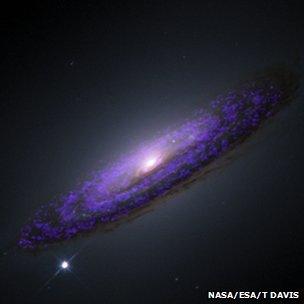Supermassive black hole weighed using new scale
- Published

The black hole at NGC4526's centre is believed to have the mass of six billion trillion trillion family cars
Researchers have proposed a new means for getting a measure of just how massive supermassive black holes are.
They are known to exist at the centres of most galaxies, but a puzzle remains as to how they affect galaxy evolution.
The approach, published in Nature, external, infers a black hole's mass from the speed of molecules swirling around it.
It could help weigh hundreds of nearby black holes. Its first use suggests a black hole in the NGC4526 galaxy has a mass 450 million times that of our Sun.
Only in a few dozen cases have the masses of supermassive black holes been estimated. Because they cannot be seen directly, astronomers have relied on guessing how large they are based on the motion of objects circling them.
Most estimates have come from gathering up starlight. This can be done by calculating how much faster the stars nearer the black hole are moving relative to those farther away.
However, that is an average measure, and the "random motions" of stars - not necessarily in the same direction as the swirling mass - blurs the measurement.
The movement of electrically charged gas can be tracked in the same way, with slightly less blurring due to random motion.
But these approaches remain painstaking and limited to only the nearest galaxies' black holes.
The new work focuses instead on cold, dense masses of gas that have markedly less random motion, and which emit their radiation in the microwave part of the electromagnetic spectrum. That allows the use of telescopes and arrays with far better resolution.
Timothy Davis of the European Southern Observatory and colleagues made use of the Carma array of telescopes in California, US, looking specifically for the radiation coming from molecules of carbon monoxide.
They focused their efforts on NGC4526, mapping out the movements of the molecules at various distances from the galaxy's central black hole.
Using their new technique, they estimated the black hole has a mass of some 900 billion trillion trillion tonnes - on the heavy side even in the supermassive stakes.
Estimates such as this may help finally unravel the interplay between black holes and the galaxies that host them.
"Galaxies and black holes seem to be related to each other; there's this relation between the mass of the black hole and properties of the galaxy," explained Dr Davis.
"That's rather weird, because these black holes are tiny compared to galaxies; they don't weigh that much, and they're physically small - less than the size of our Solar System in a galaxy that's billions of times bigger," he told BBC News.
"What we'd really like to understand is how these two components interact; why they care about each other at all. To do that, we need to be able to measure their masses, and compare them in all sorts of different galaxies. That will allow us to start answering these questions."
With the new method in hand, Dr Davis said that next-generation telescopes tuned to these microwave frequencies - such as the Alma telescope in Chile - would be able to easily acquire the masses of hundreds of black holes.
"The observations we present in the paper took over 100 hours on the Carma telescope," he said. "We estimate that with Alma you'll be able to reproduce those observation in 10 minutes. It's a real game-changer."

The estimate was based on data gathered at the 23-telescope Carma array in California
- Published14 December 2011
- Published30 August 2012
- Published5 December 2011